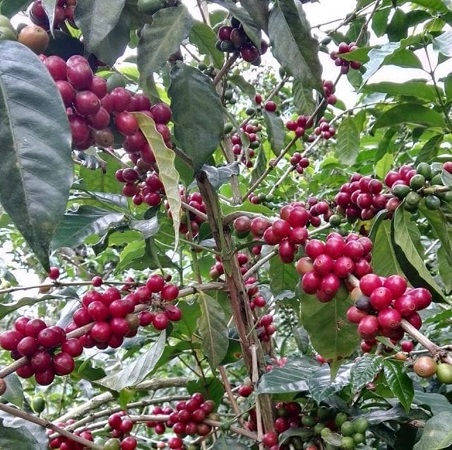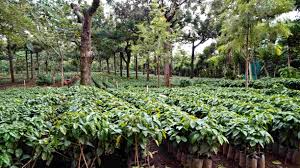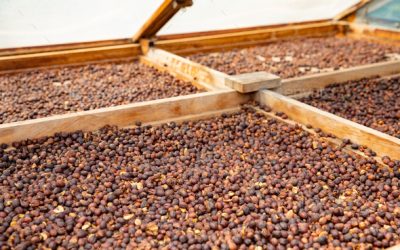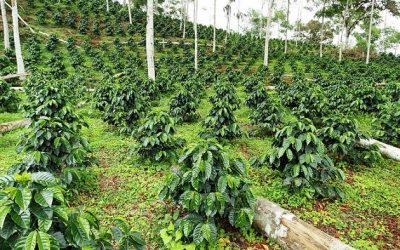Hand picking vs mechanized coffee harvesting.

Delicious specialty coffee requires excellence at every stage of the supply chain. And that means only coffee beans from the ripest of cherries should make it into the final product.
But there is more than one way to pick coffee cherries. Producers can hand pick cherries or mechanize their harvest, and their choice will impact on the coffee quality, cost of production, environmental, social impact, and more.
Hand/ manual coffee picking
Hand/manual coffee picking requires laborers to pick the coffees, quite literally, by hand. On some farms, the pickers will harvest all the cherries at one time. Often they will just put their hand around the base of a branch and then pull their hand along it, tugging all the cherries off. This is called strip picking. These farms will typically produce commodity-grade coffee.
On other farms, ones which are targeting the specialty market, they will only pick the ripe cherries. This will ensure sweeter, more complex flavours in the cup as the sugars will have had longer to develop. The pickers will have to do multiple harvests so they can pick the cherries as they ripen. This is called selective picking.
Hand/manual coffee picking is common in most countries. However, there are exceptions to this.
Mechanized coffee picking
There are two different machines used for mechanized picking.
1. Derricadeiras are smaller, handheld machines. They are a long stick with two large vibrating “hands” at the end. Laborers will place plastic or canvas underneath the coffee tree to catch falling cherries. They will then turn on the derricadeira and bring it up to the coffee branches, where the vibrations will shake the cherries loose.
2. The second option is to use stripping machines. These are much bigger, and are often driven around the farm. This means they can harvest much more coffee in the same time. They have rotating and vibrating rods that knock the cherries loose. A system of plates and pipes then catches them and transfers them to a holding bin.
Stripping machines are time-efficient, but they are not always an option because of farm topography. They can only be used where the land is relatively flat.
Mechanized harvesting is common in Brazil, Hawaii, and large farms. It’s also associated mainly with commodity coffee. However, there are some farms that use it when producing specialty-grade coffee as well.
Best Quality
The importance of only using ripe coffee cherries cannot be overstated. Under or over-ripe cherries will add unpleasant notes to the cup, and can even be considered defects. Balance, consistency, and complexity will be reduced. And if a coffee sample has too many defects, it will disqualify that coffee from specialty status.
For this reason, the majority of specialty coffee farmers use selective picking. It’s widely recommended by specialty buyers, because strip manual picking and mechanized picking tend to also harvest under-ripe and over-ripe cherries.
Coffee pickers can also gather information about the coffee tree, such as branch health, leaf health, pest-infested cherries, and early indicators of plant disease or fungi. This knowledge is crucial for monitoring plant health and coffee quality, and regular crop inspections should be made.
Yet this doesn’t mean that with other picking methods you can’t lead to quality. For example, a producer can invest more heavily in post-harvesting quality control. They can use water tanks to separate coffee cherries based on their ripeness levels, or do it manually by hand. Any under-ripe cherries would be discarded rather than left on the branch to ripen later.
More productive
Coffee farmers have to consider productivity as well as quality. And after all, quality and productivity cannot be fully separated: the longer it takes for coffee cherries to be picked, the greater the likelihood of them becoming over-ripe and even falling from the branch.
Mechanization could be considered more productive, since the machines pick the coffee quicker and cover more ground. This is particularly relevant on bigger farms.
On the other hand, it can lead to greater investment of time and effort post-processing, lowering efficiency. It could also result in lower crop yields if under-ripe coffee cherries are discarded post-harvesting.
With selective hand picking, under-ripe cherries do not need to be removed from the harvest during processing (although it’s a good idea to still use water tanks/flotation to remove defective cherries). Additionally, the unripe cherries can be left on the branch to mature and be harvested later, increasing the crop yield.
However, labor shortages could lead to coffee being unpicked and, consequently, lost crops and profits
More sustainable
It’s hard to say which method is more sustainable, especially when there are so many aspects to sustainability. In terms of social sustainability, more jobs are provided on the farm by hand picking. Yet we must consider if thes


